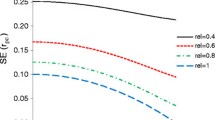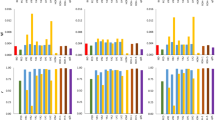Summary
The efficiencies of different experimental configurations for estimating additive (A) and heterotic (H) effects in purebred and crossbred populations derived from two parent breeds are examined. Allocation of resources over six groups is considered: the two parental breeds, the F1, the F2 and the backcrosses to the two parental breeds. Additive and heterotic effects are best estimated by allocating resources to the two parental groups and F1 in the proportions 35%, 35%, 30% and for many practical situations, an experiment involving numbers in the region 250–300 is reasonable. If it is not possible to include all three groups, other combinations involving a subset of them and some of the other three groups can be used to give estimates of A and H. However, even the best of these alternatives requires over twice the resources to give the same precision as the optimal design and, further, these estimates may be correlated. Relatively modest reallocation of resources to the F2 to estimate or test for an epistatic effect (E) leads to a minor reduction in the precision of estimates of A and H while giving reasonable precision for the estimate of E. The inclusion of maternal effects in the model greatly reduces the efficiency of estimation of A and H. Where one of the breeds is introduced through the sire line only, optimal allocation gives roughly equal replication to the pure lines and F1 but about 63% of allocation is placed in equal amounts on the two backcrosses produced through crossing F1 dams with pure sires of both breeds. The relevance of these results to the planning of livestock crossbreeding trials, particularly those involving a local and an exotic or imported breed, is discussed.
Similar content being viewed by others
References
Cunningham EP (1980) The genetic basis of heterosis. Proc 2nd World Congr Genet Appl Livestock Production, 6:190–205
Cunningham EP (1987) Crossbreeding: The Greek temple model. J Anim Breed Genet 104:2–11
Dickerson GE (1969) Experimental approaches in utilising breed resources. Anim Breed Abstr 37:191
Henderson CR (1985) Best linear unbiased prediction for nonadditive genetic merits in noninbred populations. J Anim Sci 60:111–117
Koch RM, Dickerson GE, Cundiff LV, Gregory KE (1985) Heterosis retained in advanced generations of crosses among Angus and Hereford cattle. J Anim Sci 60:1117–1132
Nelder JA, Mead R (1965) A simplex method for function minimisation. Computer J 7:308–313
O'Neill R (1971) Function minimisation using a simplex procedure. Appl Statist 20:338–345
Author information
Authors and Affiliations
Additional information
Communicated by E. J. Eisen
Rights and permissions
About this article
Cite this article
Cunningham, E.P., Connolly, J. Efficient design of crossbreeding experiments. Theoret. Appl. Genetics 78, 381–386 (1989). https://doi.org/10.1007/BF00265300
Received:
Accepted:
Issue Date:
DOI: https://doi.org/10.1007/BF00265300




